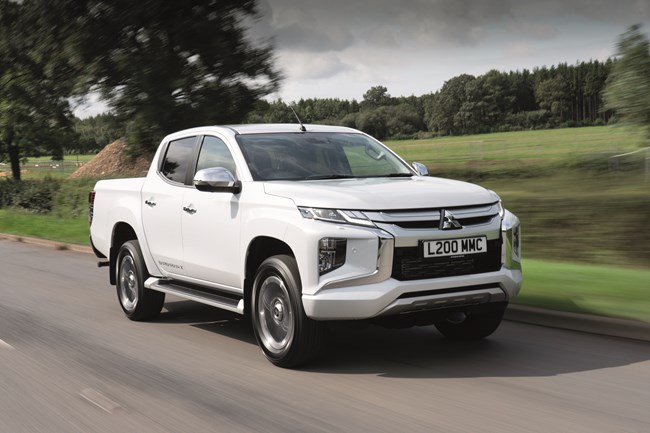- Toyota Hilux range gains new rally-inspired GR Sport II variant
- Remarketing: Pick of the bunch
- GA Commercial acquires first vans through Vanaways
- 'Luxury' tax on expensive pick-up trucks suggested
- ADVERTISEMENT FEATURE: Essential advice to avoid the van fleet ICE-berg
- ETRUX launches new Ford E-Transit Trizone
- Renault gives UK debut to Master E-Tech at CV Show
- Isuzu D-Max long-term test – Latest Report
- Isuzu D-Max V-Cross Steel Edition revealed
- IVOTY Report: Stellantis explores the hydrogen proposition
Buying a used... Mitsubishi L200
Date: Tuesday, May 9, 2023 | Author: Ian Shaw
History will record the Mitsubishi L200 as a hugely underrated pick-up.

When Mitsubishi announced its withdrawal from the market and hence the demise of the L200 pick-up, I for one, was rather sad. The maker was best known for its rally-bred fire-breathing Evo versions of its otherwise worthy if humdrum Lancer saloon with a loyal following for the Shogun from horse-y types without Range Rover money and caravanners who put function over fashion. The L200 always tried to offer more than the rest of the pick-up sector. A mid-wheelbase version in the early days of UK sales, with an increasingly sophisticated and versatile 4WD system as the years went by. However, it was always somehow less than the some of its parts, despite being more versatile than a Hilux and more reliable than a Defender.
However, the sixth generation model from 2020, ticks all the boxes. Three cab options, of single-, crew-cab and full double-cab all on a 3,000mm wheelbase give it overall lengths from 5.2 to 5.3 metres with 1.8 metres across the beam and the same for height. Load lengths are 1.85 or 1.52 metres respectively for single-cab and double-cab versions with 1.4 metres of load width reducing to 1.1 metres between the wheel arches. All will avoid the VAT man by the skin of their teeth at 1,080kgs of payload and all will tow up to 3.5 tonnes, with a GTM allowance of 6,150kgs.
The later 2.3-litre engine actually lacks a bit of torque here, but otherwise heads the older 2.4-litre lump. The 4WD transmission, is essentially a part-time affair (in the 4Work it simply is) yet the Super-Select version can run as permanent 4WD on tarmac thanks to its centre-differential, but this always locks in low-ratio. So it’s still an advantage over Defender for trailer manoeuvering. The 2.3-litre engine also ushered-in an extra cog for the automatic ‘box, matching the manual’s tally of six, when towing it masks the smaller engine’s slightly peaky torque curve.
So, the working credentials are all there yet the L200 has always traded on image. The 4Work trim level is basic but still has A/C and locking rear diff. The rest offer much more generous kit allied to names which probably seemed a good idea at the time – if tragic now. The Trojan gets the Super-Select 4WD, alloys, dual climate, auto light-n-wipe and DAB. The Warrior adds touchscreen infotainment with reversing camera whilst Barbarian gets off-road and Hill Descent modes, heated leather seats and mood lighting – which is presumably angry. The Barbarian X gets 360° cameras and blind spot detection, with rather impractical leather and suede seats.
The L200 has an enviable reliability reputation, with good cab space, refinement and kit levels. It’s payload and towing capacities are excellent, and it drives really well. Even the unladen ride comfort is noteworthy. A lot were snapped up by ‘prestige’ dealers when the retreat was announced but don’t be fooled by investment hype. Go for a mid-mileage mid-trim six-speed automatic 2.3-litre, with main dealer service history. Avoid fashionista versions and dubious accessories.
Five best options
1) 2.3 litre engine
2) Automatic transmission
3) Barbarian trim
4) Warrior trim
5) Approved accessories
Five best avoided
1) 2.4 litre engine
2) Automated transmission
3) 4Work trim
4) Trojan trim
5) Aftermarket accessories
Second-hand buys
|
Version |
Plate |
Year |
Mileage |
Price ex VAT |
|
2.4 D-Cab Warrior |
18 |
2018 |
43,000 |
£15,995 |
|
2.4 D-Cab Warrior |
19 |
2019 |
21,500 |
£18,495 |
|
2.4 D-Cab Warrior |
69 |
2020 |
26,000 |
£22,995 |
|
2.4 D-Cab Barbarian |
70 |
2020 |
74,000 |
£19,995 |
|
2.4 D-Cab Warrior |
21 |
2021 |
13,700 |
£23,795 |
View The WhatVan Digital Edition


